BSA Family |
| Intended for: | Cub Scouts |
| Details: | 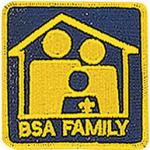 The BSA Family Award program offers activities to help strengthen all families - whether two-parent, single-parent, or nontraditional. This program helps families accomplish worthy goals while building and strengthening relationships among family members. All family members are encouraged to participate and may earn the award.
Some packs, through a volunteer family program chair, actively encourage and support families pursuing this award. If your pack does not promote and support the family program, your family may still participate on its own. The BSA Family Activity Book (available at your local council service center) gives all the requirements as well as step-by-step instructions for earning the BSA Family Award. To earn the award, a family must complete 10 activities within a 12-month period. The family chooses one activity in two topics in each of the following categories: - Learning Through Fun and Adventure
- Strengthening Family Relationships
- Developing Personal Strengths
- Teaching Responsibility
- Handling Difficult Situations
When a family has completed the requirements, all family members are eligible to receive an award certificate, patches for uniform wear, and/or pins for non-uniform wear.
The patch is a temporary emblem to be displayed centered on the right pocket or on a patch vest.
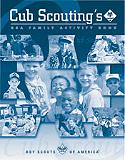 The BSA Family Activity Book is the primary resource for the BSA Family Award program. It is filled with suggested activities to enhance the children's personal development and enrich and strengthen the family.
The BSA Family Activity Book is divided into five categories that include several topics of interest to families. Each topic contains suggested activities for a family to do together. These activities could include going on field trips; telling stories; doing arts and crafts projects; playing games; participating in family discussions; or making lists, charts, and scrapbooks. Most of the ideas in the BSA Family Activity Book will be useful during family meetings or gatherings. However, parents will also find ways to incorporate them into daily life. Many ideas may be adapted for use while riding in a car and during mealtimes, and may provide things to occupy children when they say there is "nothing to do." In short, parents may use the ideas and activities to meet their own family's needs and interests.
Included with most topics are recommended books for adults and children to read together. One can find these (or other books) at a local public library. Adults and children may take turns reading aloud. There are many wonderful books to help explain or illustrate any topic the family explores.
The BSA Family Activity Book is available at your local council service center or wherever Scouting merchandise is sold. Visit www.scoutstuff.org to find a list of Scouting retailers in your area. |
Find more Scouting Resources at BoyScoutTrail.com
Centennial Quality Unit |
| Intended for: | All Scouts |
| Details: | This program has been replaced by the Journey to Excellence program starting in 2011. 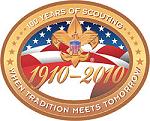 The Centennial Quality Awards program is designed to recognize units, districts, councils, areas, and regions for achieving excellence in providing a quality program to a growing youth population in America at all levels of the Boy Scouts of America.
The Centennial Quality Award is named in celebration of the 100th anniversary of the Boy Scouts of America.
The award began in 2007 and continues until 2010. Each year that you qualify, you will qualify to receive recognition for that year.
There was a red background in 2007, a white background in 2008, a blue background in 2009, and 2010 will have a red, white, and blue background.
Special note: If earned all four years, a special distinction will be available to recognize groups who qualify in 2010. The award patch is displayed on the uniform's right sleeve below the patrol emblem or den numeral. Only the most recent year's patch is worn, not a string of past year patches.     The BSA National Strategic Plan is guided by five pillars supported by measurable, specific goals. The plan requires immediate and continued attention to each pillar. Each year there will be an emphasis on one of the pillars. - 2006-Emphasized research in guiding our movement.
- 2007-Focused on helping every local council to become fiscally sound.
- 2008-Launch a campaign to engage 1 million new volunteers.
- 2009-Salute chartered organizations and strategic alliances and highlight our tradition of service.
- 2010-Celebrate our 100th anniversary.
|
Find more Scouting Resources at BoyScoutTrail.com
Crime Prevention |
| Intended for: | All Scouts |
| Details: | 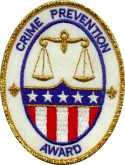 The Boy Scouts of America's Crime Prevention Program assists neighborhoods and communities in their efforts to prevent crime by emphasizing youth, family, and community.
The Crime Prevention Award
Recognitions consisting of patches, wallet cards, certificates, and pins are available. All participants, including those not registered in Scouting, are eligible to earn the Crime Prevention Award provided they fulfill the requirements of the two phases outlined below and detailed on the application form. January, 2007: I contacted BSA National about this award after hearing from someone that they could not get the patch locally. BSA replied that the Crime Prevention emblem IS in stock, however, this is a restricted item and can only be obtained through your local council. If your council does not have this in stock, they can order it. It is item #04189. Phase I-Youth and Family
Youth and family members fulfill this phase of the award by completing the activities outlined on the application form for this phase, and having a parent and/or unit leader sign the application form afterward. Phase II-Youth and Unit
This phase of the award is completed by: - Securing the approval of a unit leader for a crime prevention project, either an original project or a project of a neighborhood- or community-based organization;
- Participating with your unit, den, patrol, friends, family, neighborhood, or community in the crime prevention project; and
- Having a parent and/or unit leader sign the application form afterward.
Once both phases have been completed, the unit leader must sign the application. Awards may be purchased at the local council service center. Download the Cub Scout Application Form
or the Boy Scout Application Form.
Information for the Parent or Unit Leader
Youth
When working on crime prevention with youth, help them learn the importance of the following: - Settle arguments with words, not fists or weapons. Do not stand around and watch while others are arguing; violence often spreads into groups of bystanders.
- Learn safe routes and good places to find help in the neighborhood. Trust your feelings; if you sense danger, get away fast. Report any crimes or suspicious actions or individuals to the police, school authorities, or parents.
- Do not open the door to anyone you do not know and trust. Never go anywhere with someone you do not know and trust.
- Whenever you leave home, tell parents, relatives, or other responsible adults where you are going, who you will be with, and when you expect to be home.
- Do not use alcohol or other drugs.
- Stick with friends who are not violent and who do not use alcohol or drugs. Avoid known 'trouble spots' and difficult situations.
- If someone tries to abuse you or touch you inappropriately, yell no, get away, and tell a trusted adult.
- Get involved in making your neighborhood safer. Join with your neighbors, neighborhood associations, and local schools in these efforts.
- Help teach younger children how to avoid being victims of crime. Set a good example for them, and explain why it's important to be safe.
Family
Addressing crime prevention through families is one of the most effective ways to combat the problem. Here are some important topics for family or one-on-one discussion: - Children need to feel that someone cares enough to protect them. Adults need to set limits, rules, and standards for children. Discuss the reasons for and importance of these boundaries.
- Children need to talk about violent situations they might witness or be involved in. How might such violent situations be avoided? How can children prevent such situations from happening to themselves or their family and friends? What is a loving and supportive environment, and how is it created?
- Why is it important to be trustworthy? How does someone earn a reputation for trustworthiness? How does someone lose that reputation, and what does it feel like? Discuss how one small violation of trust can lead to larger ethical compromises.
- Is it right to 'narc on' someone you know? How does silence allow crime to flourish? Discuss ways to tell the truth about someone else's actions without suffering reprisals. Give examples.
- It can be difficult to develop a sense of respect and appreciation for one's family, community, and world. Discuss focusing on positive things-not just problems.
The following strategies and projects can involve individuals or whole families in preventing crime: - Don't keep or temporarily place weapons where children have access to them. A parent's attitude and example can be extremely influential when it comes to weapons.
- Get to know neighbors and help your children develop trust with them. Increase the awareness of everyone in your neighborhood of situations that could attract crime - for example, empty houses, open garage doors, unaccompanied children.
- Stay in touch with your children and have them stay in touch with you. Teach them how to contact you and how to find another trusted adult any time they need help.
- Offer the use of your home as a refuge and a reliable source of help for children who are frightened or need assistance.
- Organize, join, or participate in your neighborhood's or community's crime watch efforts. Help educate others about crime prevention.
Neighborhood/Community
When you focus on community crime prevention, consider participating in the following programs: - Neighborhood watch
- Child identification
- The McGruff program
- Safety for the elderly
- Local police or sheriff's department initiatives
- Church- or school-based anticrime initiatives
Consider these suggestions for crime prevention projects: - Work with local schools and parks to establish drug-free, weapon-free zones. Build a partnership with police. Focus on solving problems instead of reacting to crises.
- Help develop community pride by cleaning up the neighborhood. Involve the whole community. Contact the departments of public works or parks and recreation for specific ideas, guidance, or suggestions.
- Build a phone list of local organizations that offer counseling, job training, guidance, and other services that provide positive options to at-risk youth and families. Distribute the list in your neighborhood using local libraries, recreation centers, and other facilities.
|
Find more Scouting Resources at BoyScoutTrail.com
Cub Scout Conservation Good Turn |
| Intended for: | Cub Scouts |
| Details: | 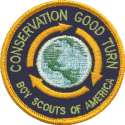 Conservation has always been an integral part of the program of Scouting America. Scouts have rendered distinguished public service by helping to conserve wildlife, energy, forests, soil, and water. Past generations of Scouts have been widely recognized for undertaking conservation Good Turn action projects in their local communities. The Conservation Good Turn is an opportunity for Cub Scout packs to join with conservation or environmental organizations (federal, state, local, or private) to carry out a conservation Good Turn in their home communities. Working together in the local community, the unit and the agency plan the details and establish the date, time and location for carrying out the project.
Conservation projects should involve the entire Cub Scout pack - scouts, leaders, and family members. Hands-on projects help Cub Scouts and Webelos Scouts realize that everyone can do things to care for the environment. Cub Scouts and Webelos Scouts participating in the Conservation Good Turn can also meet some advancement requirements.
Agencies to contact for project ideas: - U.S. Fish and Wildlife Service
- U.S. Forest Service
- Bureau of Land Management
- National Park Service
- U.S. Environmental Protection Agency
- U.S. Army Corps of Engineers
- local City Works department
- Audobon Society
- Trout Unlimited
Some suggested projects could be:- Plant grasses, trees, shrubs, and ground cover to stop soil erosion.
- As a den or pack, adopt a park and keep it clean.
- Organize or participate in a recycling program.
- Participate in a beach or waterfront cleanup. Record the items collected and determine the possible harmful effects to wildlife.
- Establish a nature trail, plant vegetation, or carry out other needed projects as requested by the camp ranger at a local BSA camp property.
The patch can be worn as a temporary insignia or on the scout's patch vest.
Pick up an application form from your local council office or
use this Application Form
|
Find more Scouting Resources at BoyScoutTrail.com
Cub Scout Outdoor Activity |
| Intended for: | Cub Scouts |
| Details: | RETIRED 2024 as part of complete Cub Scout program redesign. Many awards were redone as elective adventures.
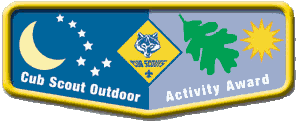
Cub Scouts at all levels from Tiger to Webelos can earn the Outdoor Activity Award. When the award is first earned, the scout receives the pocket flap award, worn on the right pocket flap of the uniform.  In each additional year that the scout earns the award, a wolf track pin is attached to the flap. The Summertime Pack Award pin should be pinned through this patch just like the wolf track pins. In each additional year that the scout earns the award, a wolf track pin is attached to the flap. The Summertime Pack Award pin should be pinned through this patch just like the wolf track pins.
Successive years should build on skills and experiences from earlier years, having the scouts participate in more extensive activities.
Requirements:
Scouts at all ranks must attend Cub Scout day camp or Cub Scout/Webelos Scout resident camp in the current program year. Tiger Scouts
Complete the Backyard Jungle adventure, and complete four of the outdoor activities listed below. Wolf Scouts
Complete the Paws on the Path adventure, and complete five of the outdoor activities listed below. Bear Cub Scouts
Complete the Bear Necessities adventure, and complete six of the outdoor activities listed below. Webelos Scouts
Complete the Webelos Walkabout adventure, and complete seven of the outdoor activities listed below. Outdoor Activities:
These activities must be in addition to any similar activities counted toward rank advancement and can be accomplished as a family, a den, or a pack. - Participate in a nature hike in your local area. This can be on an organized, marked trail, or just a hike to observe nature in your area.
- Participate in an outdoor activity such as a picnic or or a fun day in a park.
- Explain the buddy system. and tell what to do if lost. Explain the importance of cooperation.
- Attend a pack overnighter. Be responsible by being prepared for the event.
- Complete an outdoor service project in your community.
- Complete a nature/conservation project in your area. This project should involve improving, beautifying, or supporting natural habitats. Discuss how this project helped you to respect nature.
- Participate in your pack's earning the Summertime Pack Award.
- Participate in a nature observation activity. Describe or illustrate and display your observations at a den or pack meeting.
- Participate in an outdoor aquatics activity. This can be an organized swim meet or just a den, pack, or family swim.
- Participate in an outdoor campfire program. Perform in a skit, sing a song, or take part in a ceremony.
- Participate in an outdoor sporting event.
- Participate in an outdoor Scouts Own or other worship service.
- Explore a local city, county, state, or national park. Discuss with your den how a good citizen obeys the park rules.
- Invent an outside game, and play it outside with friends for 30 minutes.
|
Find more Scouting Resources at BoyScoutTrail.com
Cub Scout World Conservation |
| Intended for: | Cub Scouts |
| Details: | 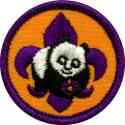 RETIRED 2024 as part of complete Cub Scout program redesign. Many awards were redone as elective adventures.
The World Conservation Award provides an opportunity for individual Cub Scouts to 'think globally' and 'act locally' to preserve and improve our environment. This program is designed to make youth members aware that all nations are closely related through natural resources and that we are interdependent with our world environment.
The Cub Scout version of the World Conservation Award can be earned by Wolf, Bear, or Webelos Scouts, but not by Lions or Tigers.
This is considered a 'temporary patch' and should be displayed centered on the right pocket. It can be sewn on or displayed in a plastic patch holder hung from the pocket button. As a Wolf Cub Scout, earn the Cub Scout World Conservation Award by doing the following: - Earn the Paws on the Path adventure.
- Select a seed, and plant it in a small container. Care for it for 30 days. Take a picture or make a drawing of your plant once a week to share with your den or family.
- Find out the growing zone for your area and share the types of plants that will grow best in your zone.
- Visit or research a botanical or community garden in your area and learn about two of the plants that grow there. Share what you learned with your den or family.
- Make a terrarium.
- Complete requirements 1 and 2 from the Spirit of the Water adventure.
- Participate in a den or pack conservation project in addition to the above.
As a Bear Cub Scout, earn the Cub Scout World Conservation Award by doing the following:
As a Webelos Scout, earn the Cub Scout World Conservation Award by doing the following: - Earn the Building a Better World adventure.
- Earn the Into the Wild adventure.
- Earn the Into the Woods adventure.
- Earn the Earth Rocks adventure.
- Outline a fair test that shows what you need to do to test a fertilizer's effect on plant growth.
- Carry out the experiment you designed in requirement 5.
- Carry out the experiment again but change the independent variable. Report what you learned about how changing the variable affected plant growth.
- Participate in a den or pack conservation project in addition to the above.
Download or complete this Application Form
|
Find more Scouting Resources at BoyScoutTrail.com
Founder's Bar |
| Intended for: | All Scouts |
| Details: |  In celebration of the 100th Anniversary of the Boy Scouts of America, the New-Unit Task Force announces the Founder's Bar recognition. This recognition is intended to emphasize the importance and pride of forming and nurturing a new Scouting unit.
The Founder's Bar is worn by all youth and adults whose names are on a new-unit charter or who officially join the new unit before the unit recharters for the first time.
This recognition is not just for new units - original charter members of units created prior to 2010 can also wear this patch, as long as the unit is still in operation and the person is still a member.
Though the bar looks similar to an Interpreter's Strip, it is worn on the left sleeve below the unit numerals.
The patch, pocket certificate, and full-size certificate are available at local scout shops.
See BSA Details page. |
Find more Scouting Resources at BoyScoutTrail.com
Heroism |
| Intended for: | All Scouts, Venturer Scouts |
| Details: | 
The Heroism Award is presented to Scouts and Scouters that have saved or attempted to save a life at minimal personal risk.
This award may be awarded to a youth member or adult leader who has demonstrated heroism and skill in saving or attempting to save life while registered in Scouting America.
If it appears that the risk involved was merely in the performance of duty or the meeting of an obligation because of responsibility to supervise and give leadership to the person or people whose lives were saved, then recognition will not be given. The Scouting America National Court of Honor determines from evidence presented which lifesaving award, if any, shall be made. The court will give consideration to resourcefulness and demonstrated skills used in rescue methods.
 Knot Description: Red on red knot on white background with white border. Knot Description: Red on red knot on white background with white border.
Award Requirements: Submit a recommendation with this Nomination Form. |
Find more Scouting Resources at BoyScoutTrail.com
Honor Medal |
| Intended for: | All Scouts, Venturer Scouts |
| Details: | 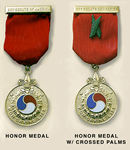 The Honor Medal is presented to Scouts and Scouters who have shown courage in attempting to save a life at considerable risk to self.
This award has been presented posthumously to Scouts who have died while attempting to save the life of another.
In very exceptional cases the award is presented with crossed gold palms to Scouts and Scouters who have attempted to save a life at extreme risk to self demonstrating exceptional heroism and extraordinary skill or resourcefulness.
 Knot Description: Red on red knot on tan background with tan border. Knot Description: Red on red knot on tan background with tan border.
Award Requirements: Submit a recommendation with this Nomination Form. The National Court of Honor decides the merits of a submitted act and decides which, if any, recognition is awarded. |
Find more Scouting Resources at BoyScoutTrail.com
International Activity |
| Intended for: | All Scouts |
| Details: | Discontinued in 2012 - see International Spirit Award 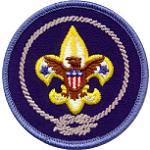 The International Activity Award is awarded to registered Youth and Adult Leaders involved in heightening awareness and cultural exchange with Scouts from other countries. The patch is worn centered on the right pocket since it is a temporary emblem. The specific requirements for earning this recognition are up to individual councils to define. BSA National has published some Suggested Criteria but you should check with your council for exact requirements.
|
Find more Scouting Resources at BoyScoutTrail.com
International Spirit |
| Intended for: | All Scouts |
| Details: | 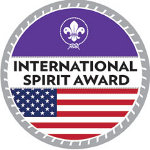 The International Spirit Award is awarded to registered Youth and Adult Leaders that have broadened knowledge of international Scouting and increased appreciation and awareness of different cultures and countries. The patch is worn centered on the right pocket since it is a temporary emblem.
Requirements:
Cub Scouts
- Earn the Cub Scout World Conservation Award.
- Learn 10 words that are in a different language than your own.
- Play two games that originated in another country or culture.
- Participate in Jamboree-on-the-Air or Jamboree-on-the-Internet.
- Organize a World Friendship Fund collection at a unit meeting or district roundtable.
- Complete two of the 10 Experience Requirements below.
Scouts BSA/Varsity/Venturer
- Earn the Scouts BSA or Venturing World Conservation Award.
- Earn the Citizenship in the World Merit Badge. (Alternative for Venturers: Complete the "Understanding Other Cultures" requirement of the TRUST Award.)
- Participate in Jamboree-on-the-Air or Jamboree-on-the-Internet.
- Organize a World Friendship Fund collection at a unit meeting or district roundtable.
- Complete three of the 10 Experience Requirements below.
Scouter
- Learn about the World Organization of the Scout Movement. Explain to your unit or at a district roundtable what this organization is and at least three ways that the WOSM website can be used to promote participation in international Scouting.
- Read the most current International Department newsletter and promote at least two items from the newsletter within your unit or at a district roundtable.
- Help organize or participate in two Jamboree-on-the-Air or Jamboree-on-the-Internet events.
- Organize a World Friendship Fund collection at a unit meeting or district roundtable.
- Complete four of the 10 Experience Requirements below.
Experience Requirements
- Host an international Scout or unit and plan activities to help you learn about Scouting in their country.
- Learn about another country and prepare a dinner traditionally served there. Explain what you learned to friends or family over the meal.
- Participate in a World Scout Jamboree, international camporee, or another international Scouting event. Share the experience with your unit or at a district roundtable.
- Take a trip to another country as an individual or with your family or Scouting unit. Make sure to visit a Scouting event or unit in that country. When you return home, share your experience with another unit.
- Organize and participate in a Messengers of Peace project. Share the experience with your unit or at a district roundtable, making sure to explain which dimensions of the program your project promoted.
- Earn the interpreter strip.
- Research Scouting in another country. Make a presentation at a unit meeting or district roundtable.
- Contact your local council's international representative and assist them with at least two items they need help with promoting.
- Research the process of obtaining a U.S. passport. Create a fact sheet for your unit or district to assist them with requirements for traveling internationally.
- Research a region of the World Organization of the Scout Movement. Make a presentation at a unit meeting or district roundtable.
See award application
|
Find more Scouting Resources at BoyScoutTrail.com
Interpreter Strip |
| Intended for: | All Scouts |
| Details: | 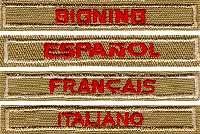 Youth and adult members (Cub Scouts, Webelos Scouts, Scouts BSA, Varsity Scouts, Venturers, and Sea Scouts, plus Scouters in all programs) may wear this strip if they show their knowledge of a foreign language or the sign language for the hearing impaired. The interpreter strips are worn centered above the "Boy Scouts of America" or "Scouts BSA" strip on the uniform.
Earn the interpreter strip by: - Carrying on a 5-minute conversation in this language.
- Translating a 2-minute speech or address.
- Writing a letter in the language (Does not apply for sign language)
- Translating 200 words or more from the written word.
Earn the Morse Code interpreter strip by:- Carrying on a five-minute conversation in Morse Code at a speed of at least five words per minute.
- Copying correctly a two-minute message sent in Morse Code at a minimum of five words per minute. Copying means writing the message down as it is received.
- Sending a 25-word written document in Morse Code at a minimum of five words per minute.
The requirements are verified by the unit leader, after receiving sufficient evidence of the Scout's or Scouter's ability to read, write, and speak the language. You can use this Interpreter Strip Confirmation form.
The unit leader should note the personal achievement on the local Council's Advancement Report for youth or Training Report for adults and submit to the Council. The unit leader purchases the strip from the local scout shop. If it is a rare language in your area, the strip may need to be ordered from a different council or National Supply Division.
Most Councils do not have a specific application form, but check with your scout shop or district executive to see.
|
Find more Scouting Resources at BoyScoutTrail.com
James E. West Fellowship |
| Intended for: | All Scouts, Venturer Scouts |
| Details: | 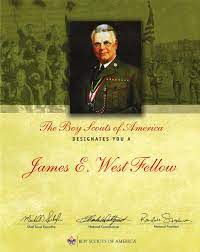 James E. West served as the first Chief Scout Executive of the Boy Scouts of America for over 30 years.
The West Fellowship award is available for gifts of $1,000 or more to a council endowment fund. The gift must be in addition to - and not replace or diminish - the donor's annual Friends of Scouting support. The James E. West Fellowship Award is an 8-by-10-inch certificate, personalized with the donor's name, date of gift, and council name.
In addition, there will be a distinctive lapel pin/charm and an embroidered square knot for uniform wear. While it is a national recognition, the James E. West Fellowship award is authorized and presented by the local council.
A registered BSA member of any age can receive this recognition. There are four levels of giving available:  - Bronze - over $1,000
- Silver - over $5,000
- Gold - over $10,000
- Diamond - over $15,000
Gifts can be given in installments over time and accumulate to reach higher levels. Knot Description: Gold on green knot on tan background with red border.
See the application form.
|
Find more Scouting Resources at BoyScoutTrail.com
Journey to Excellence |
| Intended for: | All Scouts |
| Details: | "Scouting's Journey to Excellence" is the BSA's council performance recognition program designed to encourage and reward success and measure the performance of units, districts, and councils. It replaces the Centennial Quality Awards program as a means of encouraging excellence in providing a quality program at all levels of the BSA.
Starting in January 2011, a new quality program called Journey to Excellence (JTE or sometimes J2E) has become the new national performance assessment, communication, and recognition program for units, as well as for councils and districts.
Many additional details are available on the BSA page. The award patch is displayed on the uniform's right sleeve below the patrol emblem or den numeral. Only the most recent year's patch is worn, not a string of past year patches. The Journey to Excellence program provides: - A framework for planning the year
- A method for evaluating a unit
- Guidance in areas where a unit might do better
- Specific guidelines and standards of what is considered good performance
- Early warning of potential problem areas
- Recognition for good Scouting
- Benchmarking to get ideas and tips from other good units
See BSA Info page for award details, forms, and FAQ pages.
|
Find more Scouting Resources at BoyScoutTrail.com
Medal of Merit |
| Intended for: | All Scouts, Venturer Scouts |
| Details: |  The Merit Medal honors Scouts, Venturers and Scouters that have performed an act of meritorious service above and beyond what is normally expected of a youth or adult member of Scouting America.
This act should demonstrate exceptional character that reflects an uncommon degree of concern for the well-being of others.
The action does not necessarily need to involve rescue or saving life, but must demonstrate some aspect of Scouting ideals or skills.
You can read some stories of Real Scouts in Action for some examples.  Knot Description: Gold on Blue knot on tan background with tan border.
Award Requirements: Submit a recommendation with this Nomination Form. |
Find more Scouting Resources at BoyScoutTrail.com
Messengers of Peace |
| Intended for: | All Scouts |
| Details: |  Messengers of Peace is a global initiative aimed at encouraging youth to work toward peace. Taking advantage of social media, scouts from around the world share their efforts in order to inspire other scouts to undertake similar projects.
The World Scout Committee is promoting this program and it is administered by the World Scout Bureau. Any Scout or Scouter who participates in a qualifying project can wear the Messengers of Peace ring patch. It is displayed around the World Crest above the left pocket of the uniform. Patches can be purchased by a unit representative at a local Scout Shop or council service center. A qualifying project has a significant impact on the community in one of these three dimensions of peace: - Personal dimension: harmony, justice, and equality
- Community dimension: peace as opposed to hostility or violent conflict
- Relationship between humankind and environment: security, social and economic welfare, and environment
Getting the Patch
Units that want to purchase patches should submit their Messengers of Peace related projects through the Journey to Excellence website and check the 'Messengers of Peace' box. This adds the project to the map on the Messengers of Peace website and generates a unit certificate which should be taken to the Scout Shop to purchase patches. Some Project Ideas - Personal Dimension:
- Holiday party for children of prison inmates
- Book drive for inner-city school
- Visit nursing home residents
- Participate in Feed the Children, Feed My Starving Children, Toys 4 Tots, or other organization charitable efforts
- Community Dimension:
- Build a community prayer or meditation garden
- Paint over graffiti with peace-related murals
- Participate as 'victims' for CERT or EMT training courses
- Host a day of games, sports, and activities that brings together kids from different segments of your community
- Environmental Dimension:
- Conduct a park, schoolground, campground, or river clean-up day
- Remove invasive species
- Clear brush from fire buffer zone
- Perform shoreline or natural area restoration
|
Find more Scouting Resources at BoyScoutTrail.com
National Den |
| Intended for: | Cub Scouts |
| Details: |  The National Den Award recognizes dens that conduct a quality, year-round program. Service projects, field trips, character development, and Cub Scout camping are areas that are emphasized. Dens earn the award as a team, not as individual den members. The recognition is a ribbon for the den flag or den doodle. To earn the National Den Award, a Cub Scout den must: - Have at least 50 percent of the den's Tigers, Cub Scouts, or Webelos Scouts attend two den meetings and one pack meeting or activity each month of the year.
- Complete six of the following during the year:
- Use the denner system within the den.
- In a Tiger den, use shared leadership and rotate the boy/adult host team.
- Have 50 percent of the den go on three field trips per year. A field trip may be used in place of a den meeting.
- As a den, attend a Cub Scout day camp, Cub Scout or Webelos Scout resident camp, or a council family camping event with at least 50 percent of the den membership.
- Conduct three den projects or activities leading to a discussion of the Scout Law.
- Have 50 percent of the den earn at least three elective adventure loops or adventure pins.
- Have 50 percent of the den participate in a patriotic ceremony or parade.
- Have 50 percent of the den participate in a den conservation/resource project.
- Have 50 percent of the den participate in at least one den service project.
Once the requirements are completed as stated, the signed National Den Award application is sent to the local council service center where the ribbon can be obtained.
Download an application for the National Den Award.
|
Find more Scouting Resources at BoyScoutTrail.com
National Summertime Pack |
| Intended for: | Cub Scouts |
| Details: |  RETIRED 2024 as part of complete Cub Scout program redesign. Many awards were redone as elective adventures.
A pack can qualify for the National Summertime Pack Award by planning and conducting three pack activities - one each in June, July, and August. This award can be an incentive for greater attendance at your summer pack activities.
Individual scouts that participate in all three pack events can receive the National Summertime Pack Award pin. Starting in 2008, there is a different color pin for each Cub Scout rank so earning the pin each year has more incentive.
 Qualifying packs receive a colorful streamer for their pack flag.
Dens with an average attendance of at least half their members at the three summer pack events will be eligible for a colorful den participation ribbon. The purpose of the National Summertime Pack Award is to encourage packs to provide a year-round program by continuing to meet during the time periods when school is out of session for several weeks or months. If a pack is in a 'year-round school' (or is part of a home-school association), the pack could earn the Summertime Pack Award by having a special pack activity during those breaks.
A scout that earns the Summertime Pack Award pin should display it pinned on the right pocket flap. Multiple pins may be displayed from each year it is earned.
If the scout has also earned the Outdoor Activity Award, it should be sewn on the right pocket flap and then the Summertime pin pinned through the patch. Since the goal of the Summertime award is to have Packs continue the program through the summer, the award that scouts receive should match their current rank rather than the rank they are working towards. - 1st grade - earn Tiger rank
- summer - earn Tiger summertime pin
- 2nd grade - earn Wolf rank
- summer - earn Wolf summertime pin
- 3rd grade - earn Bear rank
- summer - earn Bear summertime pin
- 4th grade - earn Webelos rank
- summer - earn Webelos summertime pin
- 5th grade - earn Arrow of Light, move on to Boy Scouts
This matching of awards and ranks is supported by emails from National BSA employees, local Scout Shop employees, and this video.
Download the Application for the National Summertime Pack Award.
|
Find more Scouting Resources at BoyScoutTrail.com
Pack Competition |
| Intended for: | Cub Scouts |
| Details: | 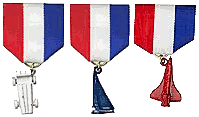 There are three Pack competitions that are commonly held as annual events. Medals can be presented to all participants and blue, red, and white medals present to first, second, and third place. The competitions are: - Pinewood Derby - gravity powered wooden cars racing down a standard track.
- Raingutter Regatta - scout breath-powered sailboats racing in a water-filled raingutter.
- Space Derby - rubber-band propellor powered rockets racing on a stretched string.
These medals can be displayed pinned above the left pocket or on a red vest. Up to five medals can be displayed on the uniform shirt.
|
Find more Scouting Resources at BoyScoutTrail.com
Participation |
| Intended for: | All Scouts |
| Details: | 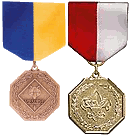 Packs and Troops will often have their own competitions between dens or patrols, or individual scouts. Districts may have competitions at camporees or other scouting events.
The BSA has official participation medals for use in any scouting activity. There are gold, silver, and bronze medals with a blue/gold ribbon for Cub Scouts or red/white ribbon for Boy Scouts. These medals can be displayed pinned above the left pocket or on a red vest or scout blanket. Up to five medals can be displayed on the uniform shirt.
There are other styles of participation and placement ribbons available at your scout shop besides these medals. |
Find more Scouting Resources at BoyScoutTrail.com
Physical Fitness |
| Intended for: | All Scouts |
| Details: | 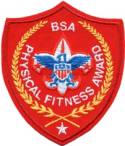 Discontinued The award's objectives, developed by the Council Services Division of the National Council and the national BSA Health and Safety Committee, are as follows: - Encourage youth fitness in the BSA by providing positive role models and by enhancing youth awareness and understanding of fitness parameters, health risks, and personal circumstances.
- Encourage physical fitness among Scouters by enhancing their awareness and understanding of fitness parameters, health risks, and personal circumstances.
- Reduce the rate of stress- and fitness-related incidents throughout Scouting.
People who earn the recognition can receive a special certificate and can purchase and wear the unique BSA Physical Fitness Award patch. In addition, upon completion of the Fitness Award requirements, Scouts and Scouters may wear a special recognition pin and patch that can be purchased through their local council.
This award is a national program of emphasis designed to heighten fitness awareness and to help change the lifestyles of American youth and adults regarding exercise and a healthy diet to improve the quality of their lives.
This award has been developed to:
- Encourage the development of attitudes, knowledge, and skills that promote fitness and safe conduct.
- Lay a skill, knowledge, and attitude foundation of the seven major components of fitness.
- Improve health, fitness, and quality of life through daily physical activity.
The BSA Physical Fitness Award's core requirements are the following seven major components. They are used to measure an individual's improvement over time, not to establish an arbitrary minimum level of activity.
Posture: Posture is evaluated with a posture-rating chart. The Scout or Scouter is compared to a photo of his or her starting posture, noting 13 different body segments. Each body segment is scored as a five, three, or one, making a possible range of scores from 13 to 65. Higher scores over time reflect improving posture.
Accuracy: The target throw is used to measure accuracy. The Scout or Scouter makes 20 throws with a softball at a circular target and is scored on the number of times the target is hit.
Strength: The sit-up is used to measure strength. The Scout or Scouter lies on his or her back with knees bent and feet on the floor. The arms are crossed on the chest with the hands on the opposite shoulders. The feet are held by a partner to keep them on the floor. Curl to the sitting position until the elbows touch the thighs. Arms must remain on the chest and chin tucked on the chest. Return to the starting position, shoulder blades touching the floor. The score is the number of sit-ups made in a given time.
Agility: The side step is used to measure agility. Starting from a center line, the Scout or Scouter sidesteps alternately left and right between two lines 8 feet apart. He or she is scored on the number of lines crossed in 10 seconds.
Speed: The dash is used to measure speed. The score is the amount of time to the nearest half-second running a set distance that can be increased each year.
Balance: The squat stand is used to measure balance. The Scout or Scouter squats with hands on the floor and elbows against the inner knee. He or she leans forward until the feet are raised off the floor. The score is the number of seconds held in that position.
Endurance: The squat thrust is used to measure endurance. The Scout or Scouter starts from the standing position. He or she performs the usual four-position exercise. The score is the number of completed squat thrusts made in a given time.
Some of these tests measure more than the components they represent. For example, the sit-ups, a measure of strength, also reflect some endurance because of their repetition. The squat stand requires balance, its major component, but also requires strength and endurance to support the weight of the body on the arms.
Requirements:
- Complete a cardiovascular fitness evaluation/consultation with your personal health care provider. (This can be done as part of the examination required by any council-approved class 3 medical evaluation.)
- Using the BSA references listed after the seven major components, give a presentation to a BSA or other community youth group (at least eight youth participants) on cardiovascular fitness, diet, the health benefits of regular aerobic exercise, exercise recommendations for the Scout-age group, and healthy lifestyles.
- Review the BSA guidelines for the Athletics and other physical activity or personal fitness-oriented merit badge and explain steps you have taken to follow each of the guidelines for the fitness goals. Explain precautions to be taken for a physical fitness activity in each of the following: woods, fields, facilities, and waterfront.
- Explain to your mentor the symptoms of dehydration and hypothermia. Explain the special considerations for preventing dehydration and hypothermia.
- Properly outfit for physical activities with proper equipment, clothing, and footwear. Know your own capabilities and limitations. Illustrate how you would prepare for the physical fitness goals included in the award program.
- With supervision from your mentor or other qualified persons, set up a fitness goal-oriented plan using the seven major components of fitness.
- Demonstrate your ability to improve your strength, posture, endurance, agility, speed, accuracy, and balance with your own goal-oriented fitness plan.
|
Find more Scouting Resources at BoyScoutTrail.com
Recruiter Strip |
| Intended for: | Cub Scouts, Scouts BSA |
| Details: |  Cub Scouts and Boy Scouts may earn the Recruiter Strip by recruiting other youth to join scouts.
The strip is worn centered directly below the right pocket on the uniform. There are no formal requirements for these strips. Each Council establishes the procedure for awarding the strip, so please check with your local council office or unit leader. Usually, a Recruiter Strip is awarded to a Cub Scout or Boy Scout the first time the scout recruits a friend, relative, classmate, or other acquaintance to join.
Normally, one strip can be awarded to a scout while a Cub Scout and another while the scout is a Boy Scout if the scout recruits at both levels.
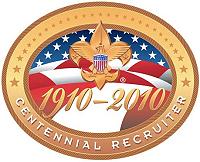 The national BSA and local Councils tend to have special recruiting drives for which collector recruiter patches are made available. For example, in 2007, the Centennial Recruiter program was held at the national level with this patch available to scouts that recruit another youth to join. This patch in addition to the recruiter strip is awarded since these kinds of patches are considered temporary patches.
Here are a couple more recruiter patches that have been available to scouts...
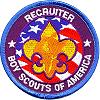 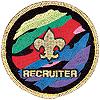
|
Find more Scouting Resources at BoyScoutTrail.com
Religious Emblem |
| Intended for: | All Scouts |
| Details: | 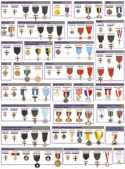 To encourage members to grow stronger in their faith, religious groups have developed religious emblems programs. The Boy Scouts of America has approved of these programs and allows the emblems to be worn on the official uniform. The various religious groups administer the programs.
Once earned, the award is generally presented by the church or religious group but may also be recognized by the Scout unit at an event such as a Court of Honor or Troop meeting or Pack meeting. This award may be earned as a youth, or presented to an adult that is nominated.
For each faith, a specific set of requirements is published and is established by the religious faith and not by BSA. For a listing of resources for each of the religious faiths that participate in this program, see the P.R.A.Y. web site Check with your local council service center or contact the religious organization directly to obtain the curriculum booklets. See BSA Page for more info.  Knot Description: silver on silver knot on purple background with purple border.
Once earned as a youth, the knot may be displayed on the uniform from that time forward. If a Scout earns the youth award and as an adult later is presented the adult award as well, both knots may be worn. |
Find more Scouting Resources at BoyScoutTrail.com
Shooting Sports |
| Intended for: | Cub Scouts |
| Details: | RETIRED 2024 as part of complete Cub Scout program redesign. Many awards were redone as elective adventures.
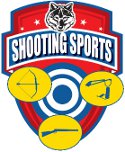 Introduced in 2016, this award has multiple levels, options, and combinations which may make the offering, tracking, and earning of the award a bit confusing for some. It isn't complicated, but ask for clarification before making assumptions. All Cub Scouts, from Lion to Webelos, can earn this award. The award is comprised of a different patch for each rank, so the patch can be earned five times. There are three shooting disciplines: BB Guns, Archery, and Slingshots.
Each discipline has two levels of proficiency. To earn an award patch, a scout completes the Level 1 requirements for any one of the three shooting disciplines. To earn a pin device for a shooting discipline, a scout completes Level 1 and Level 2 requirements for that discipline. Note for Lions: Lions and their adult partners may only participate in archery and slingshot activities, not BB Gun
 BB Gun Requirements BB Gun Requirements
(only Tiger and above, not Lions) - Level 1
- Explain what you should do if you find a gun. Recite the four safety reminders.
- On an approved range in your city or state, explain how to use the safety mechanism, and demonstrate how to properly load, fire, and secure the BB gun.
- On an approved range, demonstrate to qualified leadership good shooting techniques, including eye dominance, shooting shoulder, breathing, sight alignment, trigger squeeze, and follow-through.
- On an approved range, show how to put away and properly store BB gun shooting equipment after use.
- Level 2
- Tiger
Complete Level 1 requirements. - Demonstrate one of the positions associated with shooting BB guns.
- On an approved range, fire five BBs at the "TIGER" target. Score your target; then repeat and do your best to improve your score. (Fire a total of 10 BBs.)
- Demonstrate proper range commands, and explain how and when to use them.
- Wolf/Bear
Complete Level 1 requirements. - Demonstrate one of the positions associated with shooting BB guns.
- On an approved range, fire five BBs at the "CUB SCOUT" target. Score your target; then repeat twice and do your best to improve your score. (Fire a total of 15 BBs.)
- Demonstrate proper range commands, and explain how and when to use them.
- Tell five facts about the history of BB guns.
- Webelos/Arrow of Light
Complete Level 1 requirements. - Demonstrate the prone, bench, and sitting positions associated with shooting BB guns.
- On an approved range, fire five BBs at the "WEBELOS/AOL" target. Score your target; then repeat three times and do your best to improve your score. (Fire a total of 20 BBs.)
- Demonstrate proper range commands, and explain how and when to use them.
- Tell five facts about the history of BB guns.
 Archery Requirements Archery Requirements
- Level 1
- Demonstrate how to follow archery range safety rules and whistle commands.
- Identify and name a recurve bow and/or compound bow.
- Explain and demonstrate how to apply and use arm guards, finger tabs, and quivers.
- On an approved range, demonstrate how to safely and effectively shoot a bow and arrow, including how to establish a correct stance, nock the arrow, hook and grip the bow, raise the bow, draw, anchor, hold, aim, and release/follow through.
- On an approved range, demonstrate how to safely retrieve arrows after the range is clear and the command to retrieve arrows has been provided.
- Level 2
- Lion
Complete Level 1 requirements. - Shoot at least two arrows at a target on an approved range; repeat and do your best to improve your score. (Shoot at least four arrows.)
- Demonstrate proper range commands, and explain how and when to use them.
- Tiger
Complete Level 1 requirements. - Identify three parts of the arrow and three major parts of the bow you will be shooting.
- Shoot three arrows at a target on an approved range; then repeat and do your best to improve your score. (Shoot a total of six arrows.)
- Demonstrate proper range commands, and explain how and when to use them.
- Wolf
Complete Level 1 requirements. - Identify three parts of the arrow and four major parts of the bow you will be shooting.
- Shoot five arrows at a target on an approved range; then repeat and do your best to improve your score. (Shoot a total of 10 arrows.)
- Demonstrate proper range commands, and explain how and when to use them.
- Tell five facts about archery in history or literature.
- Bear
Complete Level 1 requirements. - Identify four parts of the arrow and five major parts of the bow you will be shooting.
- Shoot five arrows at a target on an approved range; then repeat twice and do your best to improve your score. (Shoot a total of 15 arrows.)
- Demonstrate proper range commands, and explain how and when to use them.
- Tell five facts about archery in history or literature.
- Webelos/Arrow of Light
Complete Level 1 requirements. - Identify five parts of the arrow and six major parts of the bow you will be shooting.
- Shoot five arrows at a target on an approved range; then repeat three times and do your best to improve your score. (Shoot a total of 20 arrows.)
- Demonstrate proper range commands, and explain how and when to use them.
- Tell five facts about archery in history or literature.
 Slingshot Requirements Slingshot Requirements
- Level 1
- On an approved range, demonstrate to qualified leadership good shooting techniques, including eye dominance, breathing, sight alignment, and follow-through.
- On an approved range, explain the parts of a slingshot and demonstrate how to properly use them.
- Explain the different types of ammunition that may be used with a slingshot and those that may not be used.
- Explain the different types of targets that may be used with a slingshot and those that may not be used.
- Level 2
- Lion
Complete Level 1 requirements. - Shoot two shots at a target on an approved range; then repeat and do your best to improve your score. (Shoot a total of four shots.)
- Demonstrate proper range commands, and explain how and when to use them.
- Tiger
Complete Level 1 requirements. - Shoot three shots at a target on an approved range; then repeat and do your best to improve your score. (Shoot a total of six shots.)
- Demonstrate proper range commands, and explain how and when to use them.
- On an approved range, try shooting with your non-dominant hand.
- Wolf
Complete Level 1 requirements. - Shoot five shots at a target on an approved range; then repeat and do your best to improve your score. (Shoot a total of 10 shots.)
- Demonstrate proper range commands, and explain how and when to use them.
- On an approved range, try shooting with your non-dominant hand.
- Bear
Complete Level 1 requirements. - Shoot five shots at a target on an approved range; then repeat twice and do your best to improve your score. (Shoot a total of 15 shots.)
- Demonstrate proper range commands, and explain how and when to use them.
- On an approved range, try shooting with your non-dominant hand.
- Webelos/Arrow of Light
Complete Level 1 requirements. - Shoot five shots at a target on an approved range; then repeat three times and do your best to improve your score. (Shoot a total of 20 shots.)
- Demonstrate proper range commands, and explain how and when to use them.
- On an approved range, try shooting with your non-dominant hand.
 Rules: Rules:
- All requirements must be met within the program year.
- Identical requirements completed in a previous year can not be carried forward to another year.
- Requirements can only be completed at district or council events, not on Pack outings.
- A completed tracking card is required for each scout in order to purchase awards.
Some examples: - A Tiger earns Level 1 of BB Guns and receives the Tiger award patch. The next year, as a Wolf, the scout completes Level 1 requirements for Archery and receives the Wolf award patch. If the scout wants the BB Gun device pin, the scout must complete the Level 1 requirements for BB Gun again before completing the Level 2 requirements for BB Gun.
- A Bear completes Level 1 requirements for Slingshots and receives a Bear patch. When she completes the Level 1 requirements for Archery or BB Guns, she does not receive another patch.
- A Tiger attempts to complete Level 2 for BB Guns and accomplishes requirements 1 and 2 but then the program year ends. As a Wolf, the scout must accomplish the four Level 1 requirements and then the four Level 2 requirements, including 1 and 2 which are identical to the Tiger requirements.
This is considered a temporary emblem and one should be displayed at a time centered on the right pocket. It can be sewn on or displayed in a plastic patch holder hung from the right pocket button. There are three larger stars around the target on the patch which are good spots for attaching the device pins as they are earned. See detailed shooting sports resources at this page See FAQs page for more info. |
Find more Scouting Resources at BoyScoutTrail.com
Spirit of the Eagle |
| Intended for: | All Scouts |
| Details: | 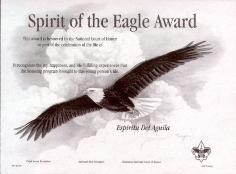 The untimely death of a promising, exemplary young person represents a tragic, sorrowful occurrence for any family and community. For that reason the Boy Scouts of America created the Spirit of the Eagle Award. This award is an honorary, posthumous recognition for a registered BSA youth member who has lost his or her life in an accident or through illness. Bestowed by the National Court of Honor as part of the celebration of the young person's life, the award recognizes the joy, happiness, and life-fulfilling experience Scouting made in that life, while also helping to heal and comfort the youth member's family, loved ones, and friends with the loss. The untimely death of a promising, exemplary young person represents a tragic, sorrowful occurrence for any family and community. For that reason the Boy Scouts of America created the Spirit of the Eagle Award. This award is an honorary, posthumous recognition for a registered BSA youth member who has lost his or her life in an accident or through illness. Bestowed by the National Court of Honor as part of the celebration of the young person's life, the award recognizes the joy, happiness, and life-fulfilling experience Scouting made in that life, while also helping to heal and comfort the youth member's family, loved ones, and friends with the loss.
Award guidelines:- recipient must be a registered youth member under 21 years of age at the time of his or her death
- unit committee must submit an application for the award within six months of the youth member's death
- unit committee must request the approval of the local council
Applications (BSA No. 92-108) are available through local council service centers or HERE.
|
Find more Scouting Resources at BoyScoutTrail.com
Find more Scouting Resources at BoyScoutTrail.com
Tech Chip |
| Intended for: | All Scouts |
| Details: | 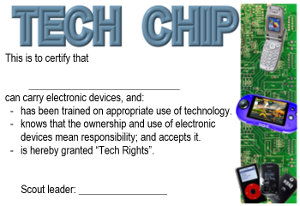 This is NOT an official BSA award. It was created by Troop 479 in Eden Prairie, MN. The troop has designed a training outline and has wallet cards for purchase - see Tech Chip Training Plan for details, or Purchase Tech Chip Cards. Some scout units ban electronic devices, such as cellphones, iPods, games, and radios, creating a situation in which adults become policemen, enforcing rules rather than training scouts. These same 'policemen' often exempt themselves from the ban, causing an unfair environment. Some even confiscate devices, putting themselves at a financial risk for that device. Scouting evolves as technology becomes available. Compasses, watches, GPS, LED lights, and other outdoor gear has improved over the years and scouts have taken advantage of those improvements. As technology continues to evolve and become more and more embedded in every part of our lives, scout leaders need to continue to make use of it. By teaching courteous use, scouts and adults can take advantage of technology to create a safer outdoors experience without reducing the value of the experience for others. This training and certification grants a scout the privilege to carry and use electronic devices at scout activities. Cub Scouts, Scouts, and Venturers can use the same training and cards.
There is no patch available at this time.
To earn this certification, the scout shows the Scout leader, or someone designated by the leader, that the scout understands their responsibility to do the following: - Recite and agree to proper use of electronic devices:
- Use only earlier than defined "Lights Out" time.
- Use when it does not interfere with other activities.
- Use when it does not affect others experience, or my safety.
- Assume all liability for the devices I bring.
- Demonstrate placing my device in silent mode.
The Scout's "Tech Privileges" can be lost if the scout fails in these responsibilities.
|
Find more Scouting Resources at BoyScoutTrail.com
Veteran Unit Bar |
| Intended for: | All Scouts |
| Details: |  As scouting units have remained continuously chartered for longer and longer lengths of time, Scouting America has introduced veteran unit bars. These cloth bars recognize units for their longevity. There is a bar for every 5 years of charter, starting with 25 years. All bars are bronze with Green or black numerals except for the 75 year bar introduced in 1985 and the 100 year bar introduced in 2010. The 75 year bar is red with silver numerals and the 100 year bar is red with gold numerals.
The bar is worn by all unit members, not just those that were members on the specific anniversary.
The bar is sewn on the uniform directly above the unit numerals. Units may choose to order custom one-piece unit numerals with the veteran bar included to reduce the number of patches to sew and ensure they are positioned correctly.
|
Find more Scouting Resources at BoyScoutTrail.com
William T. Hornaday |
| Intended for: | All Scouts, Venturer Scouts |
| Details: | Discontinued - replaced by Distinguished Conservation Service award. 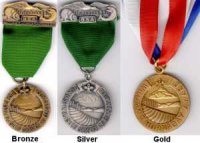 The William T. Hornaday Award recognizes Scouts and Scouters for their service to conservation and ecology efforts in their communities. There are seven different Hornaday awards with varying requirements. The youth individual awards are based on earning certain merit badges and completing one or more significant conservation projects. - The Silver Medal award is the highest possible attainment in conservation for a Boy Scout
- The Gold Medal is the highest possible attainment in conservation for a Scouter. The gold medal may be considered when a qualified Scouter is recommended by his or her council, by an established conservation organization, or by any recognized conservationist. The nominee must have demonstrated leadership and a commitment to the education of youth on a national or international level, reflecting the natural resource conservation/environmental awareness mission of the Boy Scouts of America. Nominations must be approved by the BSA's national conservation committee.
- A Unit Certificate can be awarded to a pack, troop, or crew of five or more Scouts when at least 60% of then participate in completing a unique, substantial, conservational project, but the square knot is reserved for those earning one of the medals.
These are the merit badges used for the Hornaday awards: | Energy | Fishing | Nature | | Environmental Science | Fly-Fishing | Nuclear Science | | Fish and Wildlife Management | Gardening | Oceanography | | Forestry | Geology | Plant Science | | Public Health | Insect Study | Pulp and Paper | | Soil and Water Conservation | Landscape Architecture | Reptile and Amphibian Study | | Bird Study | Mammal Study | Weather |
The categories for conservation projects are: - Energy conservation
- Soil and water conservation
- Fish and wildlife management
- Forestry and range management
- Air and water pollution control
- Resource recovery (recycling)
- Hazardous material disposal and management
- Invasive species control
Hornaday Awards:
- Hornaday Badge - Scout earns three of the bold merit badges, plus two others. Complete a project in natural resource conservation, from one of the project categories listed.
- Hornaday Bronze Medal - Scout earns the Environmental Science merit badge and at least three other bold merit badges, plus two others. Complete three projects from three separate categories listed.
- Hornaday Silver Medal - Scout earns all bold merit badges, plus any three others. Completes four projects, one each from four of the eight project categories listed.
 Knot Description: Green/blue/white on green/blue/white knot on tan background with tan border.
|
Find more Scouting Resources at BoyScoutTrail.com













 Knot Description: Red on red knot on white background with white border.
Knot Description: Red on red knot on white background with white border. 
























 The untimely death of a promising, exemplary young person represents a tragic, sorrowful occurrence for any family and community. For that reason the Boy Scouts of America created the Spirit of the Eagle Award. This award is an honorary, posthumous recognition for a registered BSA youth member who has lost his or her life in an accident or through illness. Bestowed by the National Court of Honor as part of the celebration of the young person's life, the award recognizes the joy, happiness, and life-fulfilling experience Scouting made in that life, while also helping to heal and comfort the youth member's family, loved ones, and friends with the loss.
The untimely death of a promising, exemplary young person represents a tragic, sorrowful occurrence for any family and community. For that reason the Boy Scouts of America created the Spirit of the Eagle Award. This award is an honorary, posthumous recognition for a registered BSA youth member who has lost his or her life in an accident or through illness. Bestowed by the National Court of Honor as part of the celebration of the young person's life, the award recognizes the joy, happiness, and life-fulfilling experience Scouting made in that life, while also helping to heal and comfort the youth member's family, loved ones, and friends with the loss.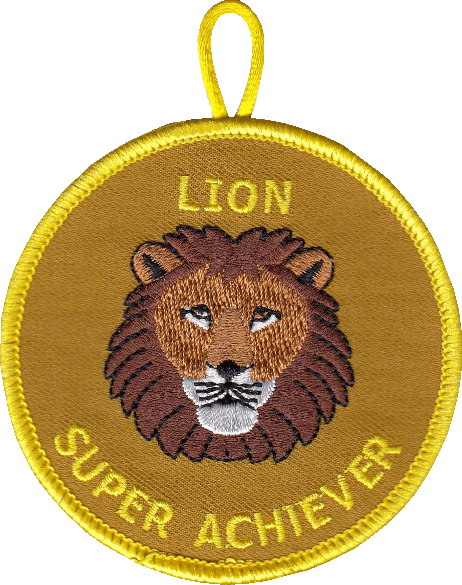
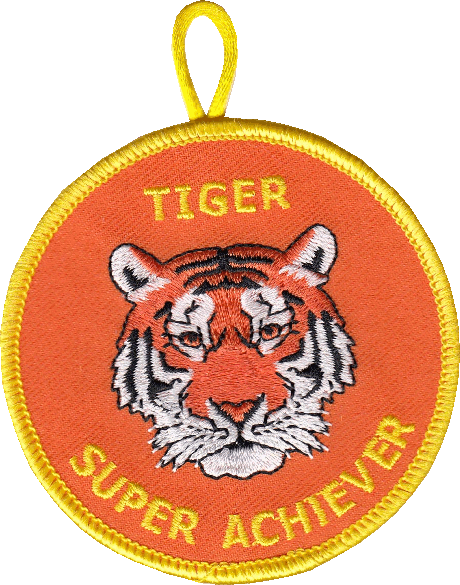
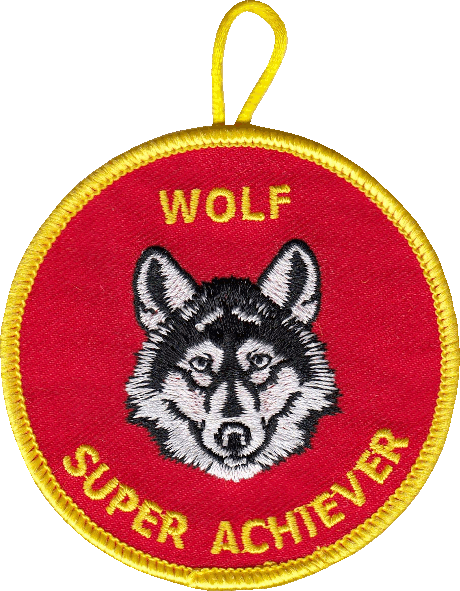
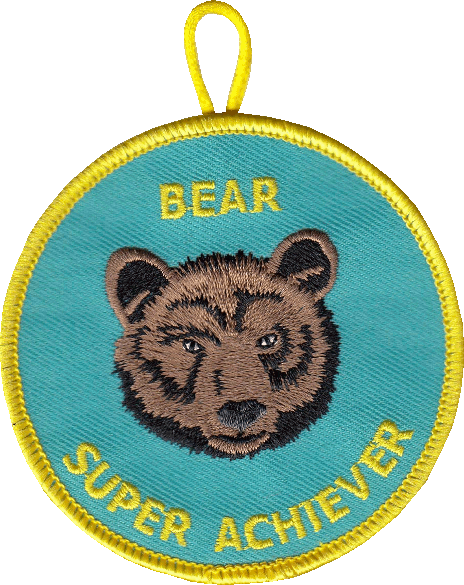
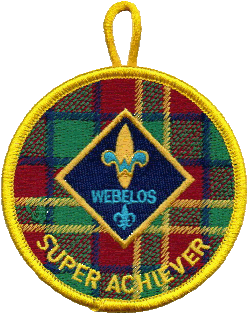











 In each additional year that the scout earns the award, a wolf track pin is attached to the flap. The Summertime Pack Award pin should be pinned through this patch just like the wolf track pins.
In each additional year that the scout earns the award, a wolf track pin is attached to the flap. The Summertime Pack Award pin should be pinned through this patch just like the wolf track pins. Knot Description: Red on red knot on tan background with tan border.
Knot Description: Red on red knot on tan background with tan border. 
 BB Gun Requirements
BB Gun Requirements  Archery Requirements
Archery Requirements  Slingshot Requirements
Slingshot Requirements  Rules:
Rules: A Favorite Award
A Favorite Award
Follow Me, Scouts
Recent Comments